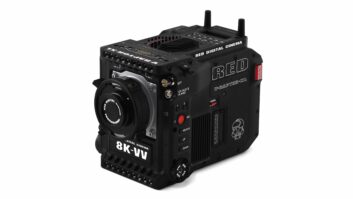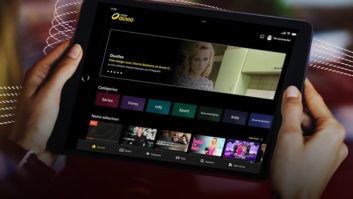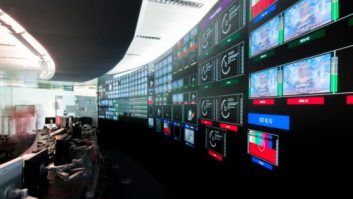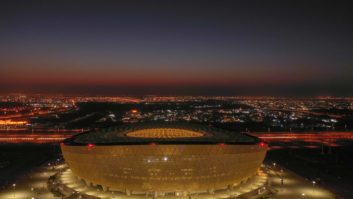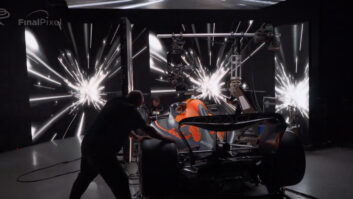The International 3D Society’s 3D Creative Arts Awards was produced in stereo for broadcast on America’s new 24/7 3D network 3net. Carolyn Giardina was at the legendary Grauman’s Chinese Theatre in Hollywood for TVBEurope.
Billed as the first 3D coverage of an Awards Show, the International 3D Society’s second annual 3D Creative Arts Awards — held February in Hollywood was lensed in 3D, including the red carpet, ceremony and fanfare of the black-tie affair. The event recognised achievements in 3D movies and television. The result is a two-hour special to air on 3net — the new 24/7 American 3D television network that is a joint venture between Sony, Discovery and Imax.
The event was held at Grauman’s Chinese Theatre in Hollywood, whose famous exterior served as the backdrop for the red carpet. Outside an OB van from HD Touring (with a second van used for 3D processing), was parked on Hollywood Boulevard. The OB van was actually a 2D van, with 3D displays set up inside for monitoring — meaning that any 2D van could be used for 3D productions. “3Ality has developed a stereo image processor that can be placed into any 2D truck,” explained 3ality Digital Telecast Producer Ted Kenney. “If you are a company out there that has a 2D truck, you don’t have to spend a million dollars to build a brand new truck. I think 3D trucks in the future will be very important, but in today’s society we have to also look at costs and the infrastructure that is readily available to most producers and productions.”
The red carpet festivities were hosted by American TV personalities Michael Corbett and Karyn Bryant.
Used to shoot the red carpet activities were 3Ality 3D rigs — one equipped with Sony HDC-1500 cameras and the other with Sony P1 cameras. 3D production company Digital Revolution Studios provided a Steadicam and a Jib, using Canon cameras. Panasonic’s AG-3DA1 cameras were tapped for additional red carpet coverage.
The interview platform was positioned in front of the Chinese theatre entrance. “I wanted to show off the hosts with this iconic background,” Kenney explained. “I couldn’t have paid for a better background.”
The production also includes what he described as a “lenticular red carpet”, which is essentially a panel system that lies on top of a carpet, manufactured by RIP Floor of Park City, Utah. “It you look at it from different angles, it moves,” Kenney explained. The material used for the 34-foot (10.2m) entrance uses custom 3D high resolution imaging in the flooring. The design was a collaboration between the RIP team and Create Advertising of Los Angeles for the design elements.
Plans are to integrate into the broadcast some clips from some winning projects, as well as looks at new and upcoming 3D productions — some of which do not yet have distribution plans. “Will they find distribution, I don’t know, but I think it is important to show all the work that is being done in 3D from studios to independent filmmakers,” Kenney commented.
Inside the theatre there were two centre positions on sticks, which were 3Ality rigs with Sony 1500s in T-block configuration; and two back of the house wide shots with the same camera configurations. A handheld P1 configuration and Steadicam from the red carpet were brought indoors for the ceremony. A P1 configuration remained on the red carpet for post-show interviews.
During the ceremony, which was hosted by Tom Cavanaugh (from the film Yogi Bear), Disney’s Tron: Legacy was named best live action 3D feature and DreamWorks Animation’s How To Train Your Dragon was honoured as best animated 3D movie. Tron and Dragon also earned trophies for best stereography in a live action and animated motion picture, respectively. Additional winners included BSkyB’s Dance, Dance, Dance, which earned a 3D television award for entertainment/music programming.
James Cameron was the recipient of the Harold Lloyd Award for 3D filmmaking and advocacy; accepting on Cameron’s behalf was Avatar Producer Jon Landau. 3D veteran Lenny Lipton was presented the Society’s Century Award for Lifetime Achievement.
The camera images were routed to a small truck where members of the 3D team monitored each camera with the ability to make adjustments with 3Ality’s SIP (stereo image processor) software, with one operator per camera. “People are controlling the convergence and interaxial, so that the 3D is smooth and easy to watch,” explained Steve Schklair, founder and CEO of 3Ality Digital.
3Ality Stereographer Nick Brown explained: “I’m making sure they are consistent in terms of depth between cameras.”
“The operator is looking more at the framing of the shot, in our truck we are judging 3D with our stereographer so they don’t have to worry about it,” Kenney added.
The images were then routed to the OB van. The footage was recorded on Sony SR 5800s and also recorded on Abekas hard disk recorders. “I wanted to do a digital record and see how those images compare to tape,” Kenney explained. “We felt Abekas was a good solution for the project and Abekas stepped up at very short notice. Basically it was a workflow test. Eventually I want to get to a point where as a production we feel comfortable with the image quality on a disk recorder we can record to a hard drive and get away from tape for some productions.”
The participants explained that although this was a recorded show, this was a live setup. Digital Revolution Studios was handling post production at press time. Executive producers of the programme are International 3D Society president Jim Chabin, Steve Schklair, and Gina Tanner, CEO/co-founder of Digital Revolution Studios. Kenney, along with Mike Piltzecker of Influence Pictures, served as producers. Veteran director Paul Miller of Rick Mill Productions directed the show.
